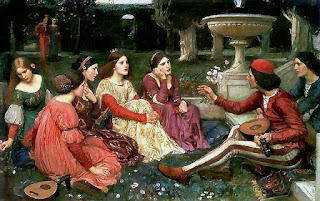She was seized with a powerful passion while reading the story of Galehaut (mentioned in yesterday's post). the theme of such a strong love "overpowered" the two. Unfortunately, she was married to Paolo's brother, who killed the two for their affair.
The two were historical figures: Francesca da Polenta, married to Giovanni Malatesta, and Giovanni's brother Paolo Malatesta (who was also married). The marriage was not one of love. Francesca's father was at odds with Giovanni's father, who was lord of Rimini. The marriage was designed to make peace between two noble and powerful families. Some time in the early 1280s, Giovanni found the two in Francesca's bedroom, and killed them.
In Dante's telling, Francesca blames the overwhelming power of Love for her actions and misfortune, accepting no blame on the part of the two lovers. Despite this, she becomes for Dante an example of the love poetry he himself wrote about earlier in his career. She tells her story without interruption, and becomes a symbol of a strong woman condemned by circumstance outside her control, because of the power of the story of Galehaut. Dante draws a parallel between the great love tale from literature and the real love tale before him.
So now we come to the point of what we started yesterday: why did Boccaccio subtitle his Decameron with Prencipe Galehaut? Boccaccio uses Galehaut—especially through the lens of his hero Dante's use of Galehaut as inspiration for Francesca's and Paolo's actions—as a symbol of his regard and compassion for women who have never been allowed the freedom of men to do as they wished. It is his acknowledgement that women should be given agency: as the women in the Decameron not only share equal social standing with the men in their ten-day community, but also in the stories told of women who manage by their wits or gain the outcomes they want.
If they were historical figures, was their affair so well-known that Dante would know the details? As it happens, remember that I told you here that he spent his final years in Ravenna? His host was Guido Novello, also known as Guido Il da Polenta, lord of Ravenna from 1316 to 1321, and the nephew of Francesca da Polenta!
Ravenna must be a little interesting, since Dante chose it for his retirement. Let's learn the delights of Ravenna next time.


























